This attraction is not something to capture on camera, but an experience you must relive yourself, following in the steps of so many pilgrims who travelled here before you in medieval times, or maybe also centuries or millenia before that. If the stress of present life is weighing you down and you feel disconnected, maybe this is your chance to get purified and reconnect, since that was precisely what this Circle was created for.

In the image above you can see a mighty mysterious thing. There is an almost perfect circle traced on the cahotic street map of our village, and everything suggests that was the origin of Peraleda. The original wall or fence has disappeared, but all 4 little squares opening at the entrance of the primitive four gates are still in place. Those four gates suggest a street crossing in the style of ancient settlements, such as in Roman times, but there is something amiss: they are not oriented to the 4 cardinal directions, as was always the case. Peraleda’s cross is pointing somewhere in the northwest. ¿Why? ¿What is or was there in that direction?
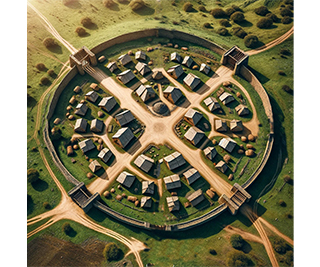
When our church was built, the centre of the temple was placed right on that same line, and for some reason they considered that the diameter of the Circle was such an important measure that the temple was built outside, but duplicating that measure exactly (126.70 m.). And now we can easily see an axis showing clearly where the Circle is pointing at. Following that line, we will arrive right at the centre of another church sitting in the middle of the country some 5 kms away, the church of Santa María.
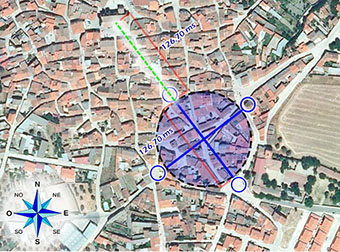
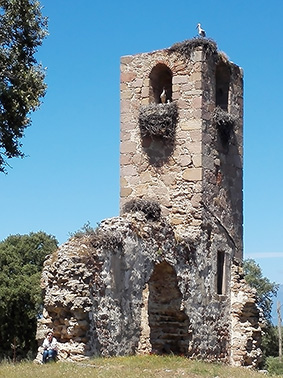
If it was all about Santa Maria’s, then we must assume that when Peraleda was founded that ancient church was already there. That means the Sacred Circle would be medieval or later than the 12th century. But there is another possibility. Peraleda may have been founded pointing to a magic or sacred spot much older, and Santa Maria was built much later on that same spot. In that case Peraleda, or at least the structure on which our village was built, could be older, even much older than the 12th century.
In that case, ¿what magic or religious place could have been that? The answer may be right next to the ruins. Down the hill we can see a source of healing waters which was very well known until the War destroyed the spa built there. For ancient people, healing waters meant there was some kind of water deity living there and giving their power to the spring (there are some Roman tombs there too). On such cases a little temple was built next to the place. In this case the temple must have been built up the hill to make it more visible and accessible. That temple becomes the focal point of the power or sacrality of the place, so it may become a centre of pilgrimage.
If this theory is correct, the Circle of Peraleda may date back to Celtic or Roman times, and though those religions died away, the memory of the sacrality of the place remained until present. This possibility gets more real when we know that, after the Romans, the Goths built a little church right there. Later the Arabs probably destroyed the temple and it was built back again after the Christian Reconquest. Adding to the sacrality of the place, tradition says that the blessed Virgin made an apparition on top of an oak bush, not to mention a long string of mysterious phenomena reported in the place still in the 20th century (UFO sights, apparitions, witches, psychophonies, and all sorts of paranormal activity). Experts in the field of telluric energies believe Santa Maria is atop an important crossing of some of those currents, thus generating a strong flow of energy.
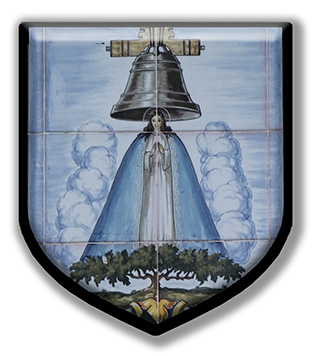
These sacred circles found at or near the end of a pilgrimage route are scattered through different parts of Europe and even the world, dating from the Middle Ages or from ancient times. In some cases we know that they function (or sometimes still function) as a device for concentrating energy, or as a final purification stage before arriving at the destiny, or both things at the same time.
As an energy collector, the Sacred Circle would work as a receptor of the sacrality of the neighbouring Santa Maria spot, working as an invisible protective cloak for the inhabitants of Peraleda. As a last stage of purification for pilgrims going to Santa Maria, the usual ritual would be going round the Circle for three times, always clockwise (just like the sun across the sky) to get purified after their long journey. After that, they would go to the centre of the circle to meditate and be purified before walking the last mile to the temple.
We don’t know for certain if Peraleda has been a pilgrimage stage since ancient times, but we do know that this was where two pilgrim routes converged in the Middle Ages. Both routes started in the middle of Spain and followed the Tagus Valley, one along the north and the other along the south, till they finally became one in Peraleda. From here the journey continued up to Santiago de Compostela (to the tomb of St James) straight through Santa Maria. It is no coincidence that the name of that church back then was Santa Maria de Compostela.
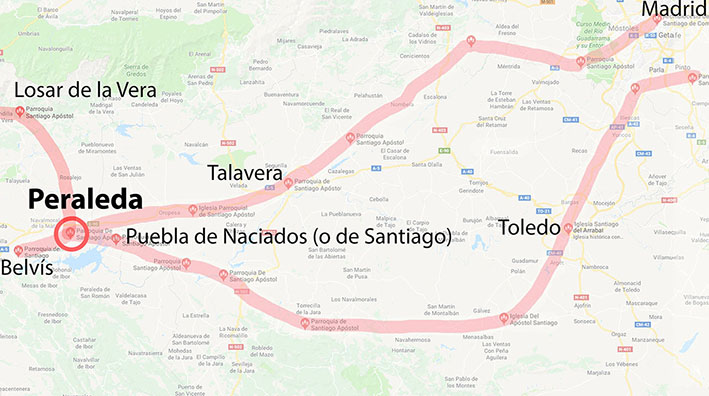
But that church was not simply yet another point in a long journey for pilgrims, the apparition of Saint Mary there turned the place into a pilgrimage destiny of its own. In fact, during the Middle Ages this place, where the image of Santa María de la Mata was venerated, was in itself, according to Fray Alonso Fernández, one of the most important Marian sanctuaries in the diocese of Plasencia (until the appearance of the image of Guadalupe in the 14 century eclipsed all others and attracted to that place all the other Marian pilgrimages).
In a nutshell, the Sacred Circle is connected with the idea of purification, protection and pilgrimage since at least the Middle Ages, although this could also be the result of the Christianization of a much older phenomenon. The important thing is that this experience is still alive, and today’s visitor can become a modern pilgrim and carry out the purification ceremony just like others before him did ages ago.
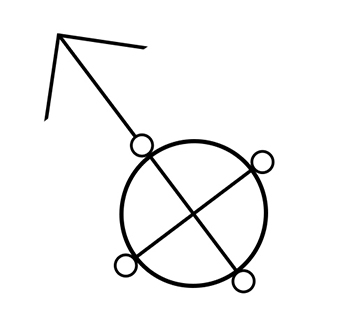
When you get to the main square, right in front of the town hall, look down on the ground for an arrow. A string of arrows will guide you until the Sacred Circle. There you will find an information panel. Go and have your own little concentrated pilgrimage going around the Circle three times (clockwise) to end up getting purified on top of the granite slab marking the middle of the Circle (this stone is called the "Centrum"), just as it was and forever will be.
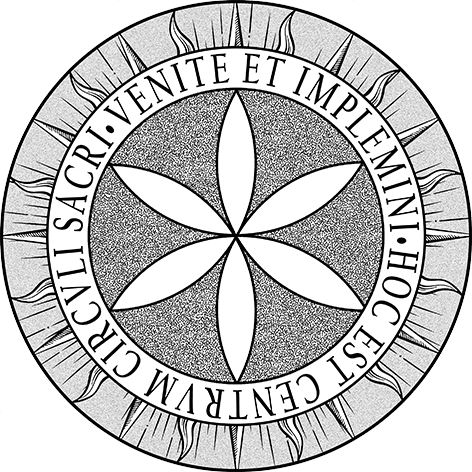
The circle pilgrimage starts here:
Escrito por Angel Castaño


